|
| |
Back to homebuilts
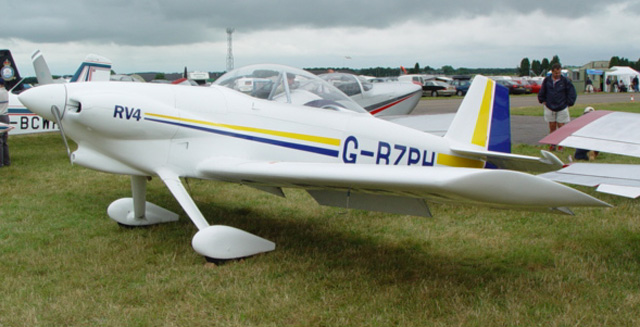 |
The Vans RV4 is one of the earliest designs
by American kit-plane expert Richard VanGrunsven (www.vansaircraft.com), first flying in
August 1979. An all metal design with just a small number of shaped
fibreglass mouldings, it is a tandem two-seater; on the power of a
150hp Lycoming O-320, it manages a cruising speed of 185mph,
achieved largely through good aerodynamics and a very clean
airframe. It is 20 feet 4 inches long with a wing span of 23 feet,
and gross weight of 1,500lb. With a range of 800 miles, it is a very
practical touring machine. This one was
at Kemble,
July 2005 |
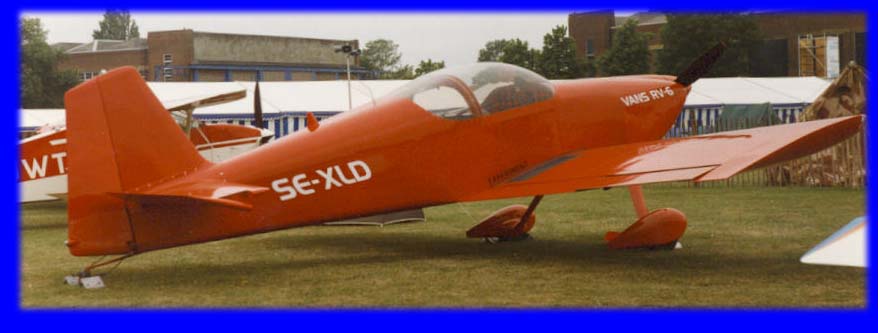 |
The Vans RV6 is based on the RV4 concept but
with its two seats side by side instead of in tandem. The changes
seating arrangement allows it to be very slightly (4 inches)
shorter, but wider (by one foot). Gross weight remains the same, but
the engine is upgraded to 160hp, which gives it a cruising speed of
160mph - when compared to the RV4, a graphic illustration of how
important total frontal area is in governing performance. But the
more sociable layout means that the RV6 is, if anything, more
popular than its predecessor. Although
my record of this picture is missing, it looks like Cranfield in the
mid 1980s. |
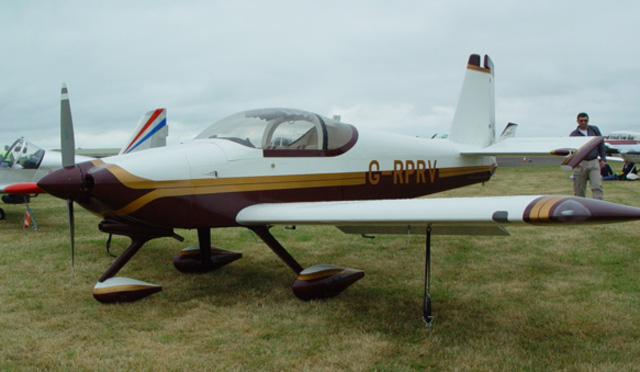 |
The Vans RV9 is a further development of the
RV range, in this case having a longer (28 foot) wing span and big
flaps to optimise the design for flying from short airstrips. First
flown in March 2002, it can be powered by a Lycoming engine ranging
from 118 to 160hp. On the higher power, it cruises at 190mph, with a
range of 700 miles (up to 1,000 in its most economic configuration).
This one was at Kemble in July 2005. |
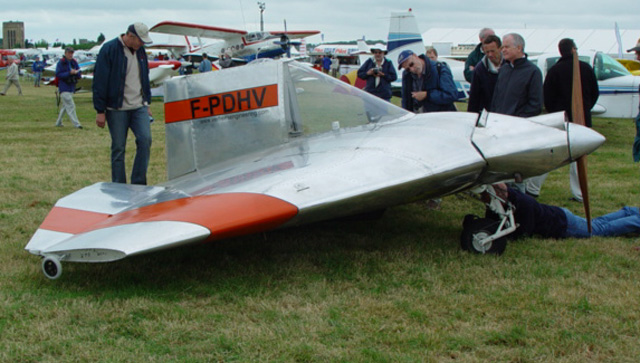 |
The Verhees Delta is a bizarre one-off design
by Bart Verhees. It is a flying wing, with a delta planform, with
the tail integrated with the cockpit. Powered by a 60hp Hirth
engine, it cruises at over 130mph - more than 2mph per horsepower!
It is a very small, all metal machine - 13 feet long, with a wing
span of 14 feet 8 inches, and a gross weight of only 660lb. And yes,
it really does fly, very well indeed.
This picture was taken at Kemble in July 2005. |
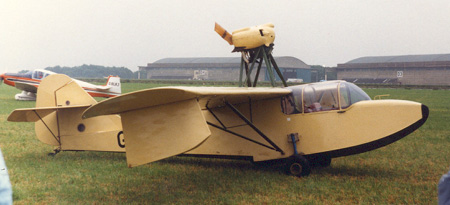 |
The Volmer VJ-22 Sportsman is one of a select
group of homebuilt amphibians. Designed by American Volmer Jensen,
it first flew as long ago as December 1958. Various engines can be
used, but a typical installation would be a 100hp Continental. The
high mounting is to keep the engine free from spray, and the pusher
propeller helps keep it free from salt damage. It is a two seater,
largely wood and fabric with some metal bracing, and the hull
covered with fibreglass to aid waterproofing. it is 24 feet long,
with a wing span of 36 feet 6 inches. it cruises at a sedate 85mph,
and has a range of 300 miles.
Once again my record of this picture has gone
astray, but it looks like Wroughton in 1988. |
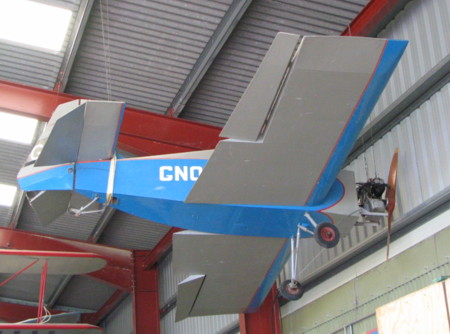 |
The Ward Gnome has the distinction of being
(I think ... open to correction here) the smallest registered
aircraft to have flown in the UK until the microlight craze began in
the 1980s. It was designed by Mr M. Ward, and was powered by a 14hp
converted Douglas motorcycle engine. Wing span is 15 feet 9 inches;
it is 11 feet 6 inches long, and has a gross weight of only 380lb.
Needless to say it is a single seater, and even more needless to say
it has very limited range (I have seen it quoted as only 50 miles).
This, the only example, is on display at the Real
Aeroplane Museum at Breighton, Yorkshire. |
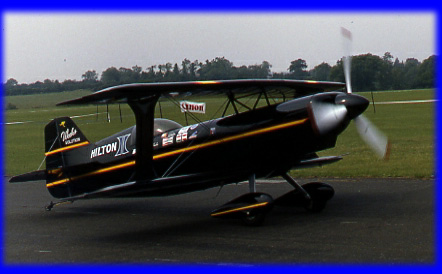 |
The Weeks Solution is a one-off aerobatic
biplane designed by the well known Florida-based enthusiast and
aerobatic pilot Kermit Weeks. The problem to which this is the
`solution' is that of aligning an aerobatic machine precisely along
the axes of a display plan, and the `solution' lies in cunning
placement of the cockpit versus high visibility points of the
airframe, such as the wing trailing edge. Mr Weeks flew the aircraft
with considerable success in aerobatic championships for many years.
The same issues contributed to the design layouts of the next
generation of high-performance aircraft such as the CAP and Extra
range. The Weeks Solution is a single seater, powered by a 300hp
Lycoming IO-540 engine, and first flew in 1980. It is 16 feet 6
inches long, with a wing span of 17 feet 6 inches.
It was pictured at South Cerney in (1986??) while
competing at the World Aerobatic Championship. |
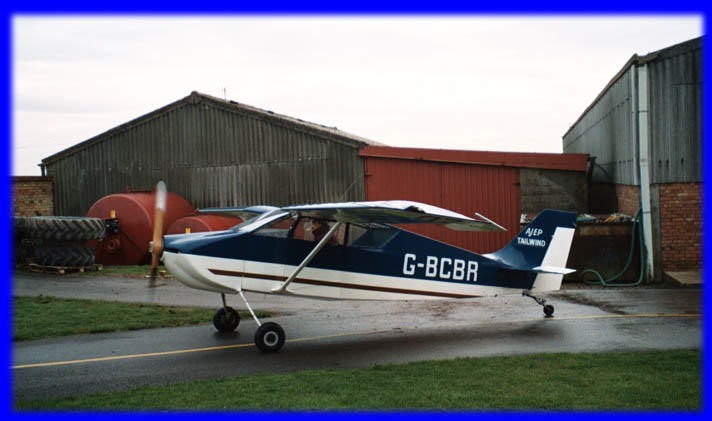
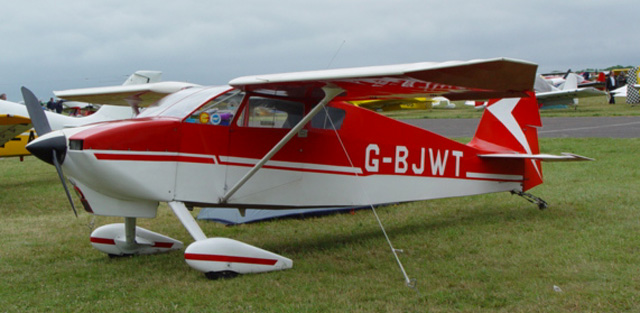 |
The Wittman Tailwind is a side by side two
seat homebuilt, originally designed by American designer S.J.
Wittman and first flown in 1953. Like many homebuilts it can take a
variety of engines, normally between 90 and 125hp. It is a simple
wood and fabric design, with a square section fuselage hosing two
seats side by side. The design
originally had a straight tail and square rear window with turned-up
wingtips (lower picture, at Fairford, July 2005). A British builder,
Mr A.J.E. Perkins, modified the design to have a swept fin, more
extensive rear cockpit glazing, and other refinements. The result
was to add several knots to the original's already respectable
cruising speed, becoming 142mph. (top picture, on a wet day at Top
Farm in 2005). Length is 20 feet 7 inches; wing
span, 22 feet 6 inches; maximum weight 1,300lb. Range is a useful
550 miles. |
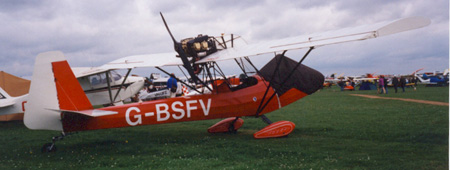 |
The Woody Pusher is a very unusual parasol
wing, two seat design, powered by an open `pusher' engine mounted on
the wing above and behind the rear seat. It was designed in America
by Harris Woods, and first flew in 1965; plans are now marketed by
Sirius Aviation (www.sirius-aviation.com/woodypusher.html).
Powered by a range of engines between 60 and 80hp, the gross weight
is a surprisingly large 1,150lb; it cruises at 100mph.
This one was at
Cranfield, Summer 1998. |
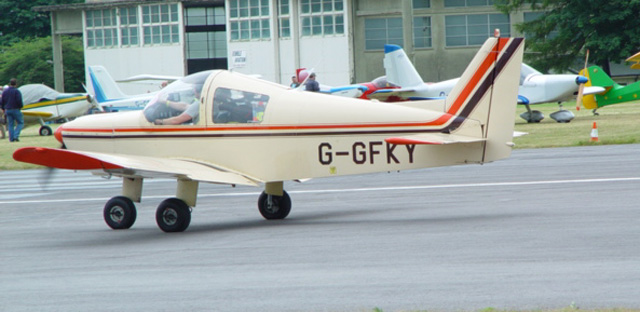 |
The Zenair CH250 Zenith is a smart little two
seat kit aircraft, designed by Christophe Heintz, formerly designer
of some of the Robin series of production aircraft. He founded
Zenair in Canada to market his designs to homebuilders. It is an all
metal two seater with a few fibreglass shaped mouldings. It can be
powered by a range of engines varying from 115 to 160hp; typical
cruising speed is 140 mph, and range is around 550 miles. It is
fully aerobatic.
This one was at Kemble in July 2005. |
|
|
The Zenair CH600 Zodiac is a two seat
aluminium kit aircraft, powered typically by a converted VW engine,
which can be fitted with either nosewheel or tailwheel undercarriage
to suit the builder's preference. It first flew in June 1984.
A notable feature is the very deep wings with high dihedral outboard
of a short flat centre section. This makes it look wider than its 26
feet 10 inches. It is 18 feet 6 inches long, with gross weight of
1,050lb. It is built for relaxing not speed: it cruises at 100mph
for a range of over 400 miles, and with a stalling speed of 45mph is
very suitable for operating out of short grass strips.
These pictures, showing the two undercarriage
options, were both taken at Kemble in July 2005. |





|